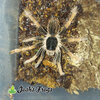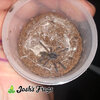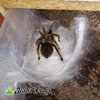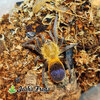- Joined
- Sep 17, 2009
- Messages
- 68
Everybody loves a blue spider!! One of the most famous and desirable of the many blue tarantulas is the Gooty Sapphire Ornamental Tarantula (Peocilotheria metallica). This spider is always breathtaking to behold. High contrast blacks and whites blend perfectly into the iridescent blues and canary yellow. This is not a subtle spider. When it first hit popularity in the US, almost 20 years ago, ¾” spiderlings were selling for $250!! That was if you could even find one to buy. Luckily, since then, enough people have bred enough of these spiders for the price to become much more reasonable. This is not a spider for the beginner. It is intolerant of conditions other than those similar to its southeast Asian rainforests. While no tarantula has venom that has ever killed a human, this tarantula has medically significant venom and could probably wreck your whole week. Even so, with proper care and caution, these amazing tarantulas make incredible display animals.


Meet Betty White Knee! Betty is a Brazilian Giant White Knee Tarantula, Acanthoscurria geniculata. Her kind comes from the Amazon basin of northern Brazil. Her species was first described by Anton Ausserer in 1871, but were not popular in the Tarantula Keeping Hobby until around 25 years ago. The genus name, “Acanthoscurria” comes from Greek words meaning "spine" and "to run". This reflects the spiny appearance and agile movements of these tarantulas. The word geniculata comes from the Latin word geniculum, which is a diminutive of genu meaning "knee". Geniculata means "on bended knee". This reflects both the typical stance of this tarantula as well as the bright white epaulettes on the “knees”, also known as the patellas. Betty is generally a very tolerant and confident tarantula, often seen out and about in her habitat. We expect to have her for quite some time to come, due to her 20+ year life spam! We will keep you updated on Betty as she grows, molts, or breeds again.



Meet Betty White Knee! Betty is a Brazilian Giant White Knee Tarantula, Acanthoscurria geniculata. Her kind comes from the Amazon basin of northern Brazil. Her species was first described by Anton Ausserer in 1871, but were not popular in the Tarantula Keeping Hobby until around 25 years ago. The genus name, “Acanthoscurria” comes from Greek words meaning "spine" and "to run". This reflects the spiny appearance and agile movements of these tarantulas. The word geniculata comes from the Latin word geniculum, which is a diminutive of genu meaning "knee". Geniculata means "on bended knee". This reflects both the typical stance of this tarantula as well as the bright white epaulettes on the “knees”, also known as the patellas. Betty is generally a very tolerant and confident tarantula, often seen out and about in her habitat. We expect to have her for quite some time to come, due to her 20+ year life spam! We will keep you updated on Betty as she grows, molts, or breeds again.

Last edited by a moderator:





































